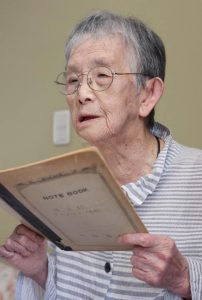Making their voices heard — 60 years after Hiroshima-Nagasaki World Peace Pilgrimage, Part 2: Cultivating courage
Jul. 18, 2024
Sense of mission as living witness
by Hiromi Morita, Staff Writer
Shizuko Abe’s hands and face with their taut burn scars have not returned to their original state despite the many years since the atomic bombing. “I was frightfully disfigured and spent my days in tears,” said Ms. Abe, 97, a resident of Hiroshima’s Minami Ward who was a member of the 1964 Hiroshima-Nagasaki World Peace Pilgrimage, as she looked off into the distance.
“I am now able to hold my head up and speak with people, thanks to the courage I gained then. I learned that even someone like me can tell important stories, because I am a ‘living witness,’” she said firmly, as she held on to her travel diary from that time. Even while living in a home for seniors, she speaks about her experience in the atomic bombing and her life afterward at the request of civic groups, the media, and young people.
On the day of the atomic bombing, she was engaged in the work of demolishing houses for the creation of fire lanes about 1.5 kilometers from the hypocenter as part of volunteer community work. Working outdoors, she was exposed to intense thermal rays from the bombing. Her face was burned and the skin on her right arm peeled off to the tips of her fingernails. Although she had escaped death, her burns became swollen and turned bright red.
She was 18 at the time and had just married. Her mother-in-law, with whom the couple lived, pushed her for a divorce from her son. She got strange looks from people around her, and children in the neighborhood used to call her a “red ogre.” She prepared herself for a divorce, but her husband, Saburo, who was demobilized from the military at the end of that year, did not even bat an eye at her completely changed appearance and treated her with compassion. Saburo died in 1992.
Supported by husband
One summer, she saw a sign at one of the shacks next to the A-bomb Dome that read, “Let us know if you are an A-bomb survivor.” The sign was written by Kiyoshi Kikkawa, the person known as “Atomic Bomb Victim No. 1” who died in 1986. Ms. Abe developed a close friendship with Mr. Kikkawa and others who devoted themselves to the A-bomb survivors’ movement in its early days. It was on their advice that she joined the pilgrimage proposed by Barbara Reynolds, an American peace activist who died in 1990.
The pilgrimage was Ms. Abe’s first trip overseas, and she bore the heavy burden of speaking out to people in nuclear weapons states and other nations over a period of about two-and-a-half months about the suffering caused by the atomic bombings. As a housewife who worked on the family farm and took care of the family’s children and housework, being away from home was a grave matter. “I thought it would be impossible for me, as I had lived my life trying to hide from people,” she said. “But my husband encouraged me by telling me it was an honorable role.”
Saburo supported his wife during her trip with letters and even contributed an article to a Japanese-language newspaper in the United States. He wrote that the A-bomb survivors were not there to be exposed to public view or to beg for mercy, and that he had sent his wife off for the purpose of “having as many people in as many countries as possible learn about the hopes of the A-bomb survivors in Hiroshima.”
With such support from the A-bombed cities, the 40-member pilgrimage group, including interpreters, rushed around different places, staying with host families along the way. In the United States, they met with Harry Truman, the U.S. president at the time of the atomic bombings. Ms. Abe said, “He didn’t offer any apology (for dropping the atomic bombs), which left me feeling empty inside.” They also met the secretary-general of the United Nations. They spoke of their experiences at schools and churches, and even held a rally at New York’s Carnegie Hall to raise money for the pilgrimage, as funds were running short.
Shaped future direction in life
Coming in contact with people who wanted peace in the United States, where the vast majority of people had voiced their support of the atomic bombings, softened her hatred of the country. “We must make sure that no one, including these people, should ever experience the same suffering.” That idea led her to continue sharing the story of her A-bombing experience with students on school excursions until around 10 years ago.
Hiromu Morishita, 93, a resident of Hiroshima’s Saeki Ward who devoted himself to peace education as an A-bomb survivor and teacher, also explained how the pilgrimage had determined his future direction in life. “Depressed A-bomb survivors went out into the world to speak and, after hearing their stories, some people began to believe that the atomic bombings were wrong,” said Mr. Morishita. He added, “It made me feel like I could do something big, something I could never have expected.”
Mr. Morishita holds the title of honorary chairperson of the World Friendship Center, an organization that Ms. Reynolds and others founded after the pilgrimage. Now, a time marked by fears regarding use of nuclear weapons amid the persistent flames of war, Mr. Morishita once again considers the significance of the pilgrimage while organizing related materials. He said, “The current situation is becoming more severe than during the Cold War period. That is exactly why we must use the memories of those days as momentum for a step toward peace.”
(Originally published on July 18, 2024)








